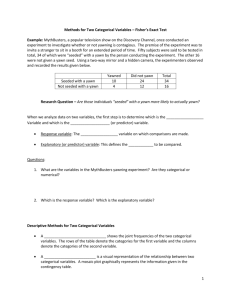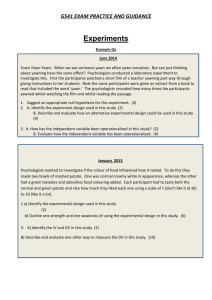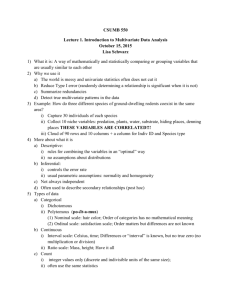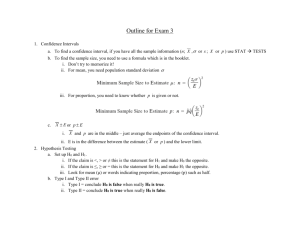Section 5.1
advertisement
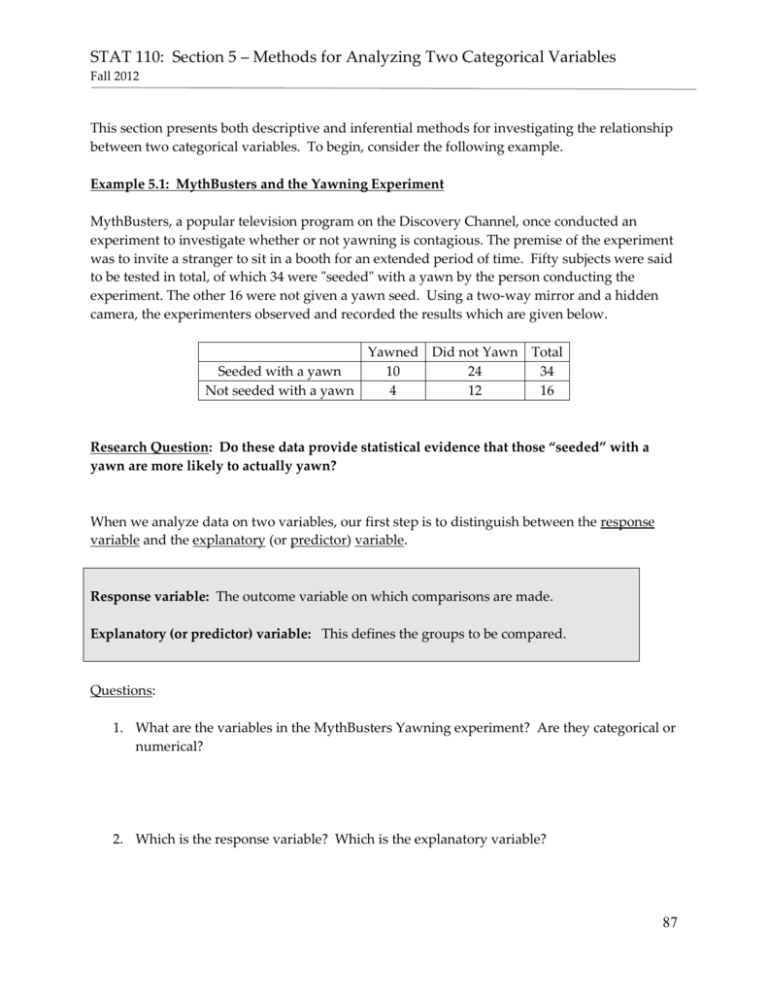
STAT 110: Section 5 – Methods for Analyzing Two Categorical Variables Fall 2012 This section presents both descriptive and inferential methods for investigating the relationship between two categorical variables. To begin, consider the following example. Example 5.1: MythBusters and the Yawning Experiment MythBusters, a popular television program on the Discovery Channel, once conducted an experiment to investigate whether or not yawning is contagious. The premise of the experiment was to invite a stranger to sit in a booth for an extended period of time. Fifty subjects were said to be tested in total, of which 34 were "seeded" with a yawn by the person conducting the experiment. The other 16 were not given a yawn seed. Using a two-way mirror and a hidden camera, the experimenters observed and recorded the results which are given below. Seeded with a yawn Not seeded with a yawn Yawned Did not Yawn Total 10 24 34 4 12 16 Research Question: Do these data provide statistical evidence that those “seeded” with a yawn are more likely to actually yawn? When we analyze data on two variables, our first step is to distinguish between the response variable and the explanatory (or predictor) variable. Response variable: The outcome variable on which comparisons are made. Explanatory (or predictor) variable: This defines the groups to be compared. Questions: 1. What are the variables in the MythBusters Yawning experiment? Are they categorical or numerical? 2. Which is the response variable? Which is the explanatory variable? 87 STAT 110: Section 5 – Methods for Analyzing Two Categorical Variables Fall 2012 Descriptive Methods for Two Categorical Variables: A contingency table shows the joint frequencies of two categorical variables. The rows of the table denote the categories of the first variable, and the columns denote the categories of the second variable. The following mosaic plot and contingency table were created in JMP by using the Fit Y by X option. Note that this table includes row percentages in addition to observed counts. (Y = Yawned and X = Group) Questions: 1. Find the proportion that yawn in the Seeded group. 2. Find the proportion that yawn in the Not Seeded group. 88 STAT 110: Section 5 – Methods for Analyzing Two Categorical Variables Fall 2012 3. Find the difference in the proportion that yawn between these two groups. Do these proportions differ in the direction conjectured by the researchers? 4. Even if the seeding of a yawn had absolutely no effect on whether or not a subject actually yawned, is it possible to have obtained a difference such as this by random chance alone? Explain. Inferential Methods: Conducting a Simulation Study with Tinkerplots The above descriptive analysis tells us what we have learned about the 50 subjects in the study. Can we make any inferences beyond what happened in the study (i.e., general statements about the population)? Does the higher proportion of yawners in the seeded group provide convincing evidence that being seeded with a yawn actually makes a person more likely to yawn? Note that it is possible that random chance alone could have led to this large of a difference. That is, while it is possible that the yawn seeding had no effect and the MythBusters happened to observe more yawners in the seeded group just by chance, the key question is whether it is probable. We will answer this question by replicating the experiment over and over again, but in a situation where we know that yawn seeding has no effect (the null model). We’ll start with 14 yawners and 36 non-yawners, and we’ll randomly assign 34 of these 50 subjects to the seeded group and the remaining 16 to the non-seeded group. In Tinkerplots, your sampler window should be set up as follows. Note that you can drag and drop a new mixer to the right of the existing mixer in order to link the two. 89 STAT 110: Section 5 – Methods for Analyzing Two Categorical Variables Fall 2012 Each mixer contains 50 “subjects.” The first mixer contains 14 yawners and 36 non-yawners; the second mixer contains 34 subjects in the Seeded group and 16 in the Non-seeded group. Make sure the Repeat value is set to 50, and set BOTH mixers to sample Without Replacement (as shown below). Questions: 1. Why is the Repeat value set to 50? 2. Why do we sample “without replacement” in this simulation study? 90 STAT 110: Section 5 – Methods for Analyzing Two Categorical Variables Fall 2012 Next, click Run, and you will see the results of the first simulated trial: To plot these results, drag a new Plot to the workspace. Drag the predictor variable (Group) to the x-axis and the response variable (Yawn) to the y-axis, as shown below. Click on N to count the number in each cell, and note that you can also vertically stack the dots using the Stack tool. 91 STAT 110: Section 5 – Methods for Analyzing Two Categorical Variables Fall 2012 Using the results of the first trial of your simulation study, construct the contingency table to show the number of yawners and non-yawners in each group. Yawned Did not Yawn Total Seeded with a yawn 34 Not seeded with a yawn 16 Total 14 36 50 Next, note that if you know the number of yawners in the Seeded group, then you can fill in the rest of the cells in the contingency table. So, we need only focus on the number of yawners in the Seeded group. To keep track of the number of yawners in the Seeded group while carrying out many more trials, place your cursor over this number (circled in red on the below graph), right-click, and choose Collect Statistic. Set the Collect value to 99 in order to obtain a total of 100 simulated results, and click Collect. Finally, to graph these outcomes, highlight the “Num_Seeded_Yawn” column and drag a new plot into the workspace. Drag a point all the way to the right to organize the dots, and use the Stack tool to vertically stack the dots. Finally, right-click on either endpoint on the x-axis and set “Bin Width” to 1, and use the count tool (N) to count the dots in each bin. 92 STAT 110: Section 5 – Methods for Analyzing Two Categorical Variables Fall 2012 You should see something similar to the following: Questions: 1. What does each dot on the above plot represent? 2. How often did you see results at least as extreme as the observed data (10 or more yawners in the seeded group) under the null model? Calculate the proportion of simulated results in which you observed 10 or more yawners in the seeded group. Note that this is an approximate p-value! 3. Note that the random process used in the simulation study models the situation where the yawn seeding has no effect on whether the subject actually yawns—we simply assume there are 14 people who will yawn no matter what group they are in, and they are assigned to the two groups at random . Based on this simulation study, does it appear that random assignment of yawners to groups will result in 10 or more yawners in the Seeded group just by chance? Explain. 93 STAT 110: Section 5 – Methods for Analyzing Two Categorical Variables Fall 2012 4. The MythBusters reported the following results: 25% yawned of those not given a yawn seed, and 29% yawned of those given a yawn seed. Then, they cited the "large sample size" and the 4% difference in the proportion that yawned between the seeded and nonseeded group to confidently conclude that yawn seed had a significant effect on the subjects. Therefore, they concluded that the yawn is decisively contagious. Do you agree or disagree with their answer? Justify your reasoning. Inferential Methods: Fisher’s Exact Test to Obtain Exact p-values We just used a simulation study to answer the research question of interest to the Mythbusters. This is a valid analysis; however, it provides only an approximate p-value. We can obtain the exact p-value using probability theory and a distribution known as the hypergeometric distribution. Details about the hypergeometric distribution are beyond the scope of this course; however, we will discuss Fisher’s exact test which uses the hypergeometric distribution to calculate p-values. The Mythbusters Yawn data entered into JMP would like the spreadsheet shown below. In order to get that test for statistical significance of these results you would select Fit Y by X from the Analyze menu and put Group in the X box and whether or not they Yawned in the Y box. 94 STAT 110: Section 5 – Methods for Analyzing Two Categorical Variables Fall 2012 The following JMP output provides us with the potential p-values for Fisher’s exact test: JMP has already used the hypergeometric probability distribution to calculate the probability of observing results at least as extreme as those observed in the MythBusters actual experiment. JMP will always give you three p-values, one for each of the potential research or alternative hypotheses you might consider in an experimental situation such as this. The three p-values given are for testing the following: (1) Left, p-value = .7417 is for testing if the proportion of people yawning is greater for the group that did not receive a yawn seed than it is for the group that did witness a person yawning, i.e. received a yawn seed. How did we know this is the alternative from the shorthand that JMP uses? Prob(Yawned=Yawned) is greater for Group = No Seen than Seeded Yawn Probability that the response is Yawned The probability of yawning is greater for the group that was not seeded by seeing another person yawn than for the group that was. This is clearly not supported as the p-value >> .05. (2) Right, p-value = .5128 is for testing if the proportion of people yawning is greater for the group that did receive a yawn seed that it is for the group that did not witness a person yawning. The fact this p-value is NOT significant suggests that we do not have evidence to suggest a person is more likely to yawn after seeing another person yawn. This was the research hypothesis for the MythBusters experiment. How did we know this is the alternative from the shorthand that JMP uses? Prob(Yawned=Yawned) is greater for Group = Seeded Yawn than No Seed Probability that the response is Yawned The probability of yawning is greater for the group that was seeded by seeing another person yawn than for the group that was not. 95 STAT 110: Section 5 – Methods for Analyzing Two Categorical Variables Fall 2012 (3) 2-Tail, p-value = 1.000 is for testing if the proportion of people yawning risk differs between the two groups. The fact this p-value is so large (largest possible actually) suggest we have absolutely NO evidence to conclude the proportion of people yawning differs significantly between two groups. Prob(Yawned=Yawned) is different across group. The probability of yawning differs between the two groups. Now, you can use this output to carry out the test. Carrying out Fisher’s Exact Test This test is based on the probability of observing data at least as extreme as the actual observed data. The procedure is carried out as follows. Step 1: Convert the research question into Ho and Ha. H0: The proportion of yawners is equal for the Seeded and Non-seeded groups (i.e., the yawn seeding has no effect on whether or not a person yawns). Ha: The proportion of yawners in the seeded group is larger (i.e., those seeded with a yawn are more likely to yawn.) Step 2: Determine the p-value. p-value: 96 STAT 110: Section 5 – Methods for Analyzing Two Categorical Variables Fall 2012 Step 3: Write a conclusion in terms of the original research question. Example 5.2 Vested Interest and Task Performance This example is from Investigating Statistical Concepts, Applications, and Methods by Beth Chance and Allan Rossman. 2006. Thomson-Brooks/Cole. “A study published in the Journal of Personality and Social Psychology (Butler and Baumeister, 1998) investigated a conjecture that having an observer with a vested interest would decrease subjects’ performance on a skill-based task. Subjects were given time to practice playing a video game that required them to navigate an obstacle course as quickly as possible. They were then told to play the game one final time with an observer present. Subjects were randomly assigned to one of two groups. One group (A) was told that the participant and observer would each win $3 if the participant beat a certain threshold time, and the other group (B) was told only that the participant would win the prize if the threshold were beaten. The threshold was chosen to be a time that they beat in 30% of their practice turns. The following results are very similar to those found in the experiment: 3 of the 12 subjects in group A beat the threshold, and 8 of 12 subjects in group B achieved success.” A: Vested Interest B: No Vested Interest Total Achieved success 3 8 11 Did not achieve success 9 4 13 Total 12 12 24 97 STAT 110: Section 5 – Methods for Analyzing Two Categorical Variables Fall 2012 Research Question: Does having an observer with a vested interest decrease performance on a skill-based task? Questions: 1. What are the variables in the study? Are they categorical or numerical? 2. Which is the response variable? Which is the explanatory variable? The data can be entered into JMP as follows: To create the contingency table and mosaic plot in JMP, select Analyze > Fit Y by X. As always, place the response variable in the Y, Response box and the explanatory variable in the X, Factor box. 98 STAT 110: Section 5 – Methods for Analyzing Two Categorical Variables Fall 2012 Click OK, and JMP returns the following: Questions: 3. What is the proportion of successes (beating the threshold) for each group? 4. What is the difference in the proportion of successes between these two groups? Do these proportions differ in the direction conjectured by the researchers? 5. Even if the observer’s interest had absolutely no effect on subjects’ performance, is it possible to have obtained a difference such as this by random chance alone? Explain. 99 STAT 110: Section 5 – Methods for Analyzing Two Categorical Variables Fall 2012 6. What would the counts for the “most extreme” table look like? Note that we keep the row and column totals the same. 7. Give a few more examples of tables that are more extreme than the observed data but not as extreme as the “most extreme” table shown above. Keep in mind that a p-value is always the probability of seeing results at least as extreme as the observed data. So, JMP uses what is known as the hypergeometric distribution to find the probability of seeing the observed data table and EACH table that is more extreme, assuming that there is no difference in the two groups being compared. The sum of these probabilities is the p-value from Fisher’s exact test. Fisher’s Exact Test to Obtain Exact p-values Step 1: Convert the research question into Ho and Ha. H0: The proportion of successes in group A is the same as in group B. Ha: The proportion of successes in group B is larger (i.e., having an observer with a vested interest would decrease subjects’ performance on a skillbased task) 100 STAT 110: Section 5 – Methods for Analyzing Two Categorical Variables Fall 2012 Step 2: Determine the p-value and make a decision concerning H0. p-value: Step 3: Write a conclusion in terms of the original research question. 101 STAT 110: Section 5 – Methods for Analyzing Two Categorical Variables Fall 2012 Example 5.3: Claritin and Nervousness An advertisement by the Schering Corporation in 1999 for the allergy drug Claritin mentioned that in a pediatric randomized clinical trial, symptoms of nervousness were shown by 4 of 188 patients on Claritin and 2 of 262 patients taking a placebo. Research Question: Is there evidence that the proportion who experience nervousness is greater for those who take Claritin than for those who take the placebo? The data can be found in the file Claritin.JMP on course website. Questions: 1. Which is the response variable? 2. Which is the explanatory variable? 3. Fill in the following contingency table: Nervousness? Drug Yes No Row Totals (Fixed) Claritin Placebo Total 102 STAT 110: Section 5 – Methods for Analyzing Two Categorical Variables Fall 2012 Next, use JMP to carry out Fisher’s Exact Test for these data: Step 1: Convert the research question into H0 and Ha. H0: Ha: Step 2: Determine the p-value and make a decision concerning H0. p-value: Step 3: Write a conclusion in terms of the original research question. 103 STAT 110: Section 5 – Methods for Analyzing Two Categorical Variables Fall 2012 Review: Observational Studies vs. Designed Experiments Reconsider the “Vested Interest and Task Performance” example. Fisher’s exact test provided evidence that the proportion of successes was in fact smaller for the vested interest group (p-value = .0498). Now, the question is this: can we really conclude that having a vested interest really is the cause of the decreased performance? The answer to this question lies in whether the experiment itself was a designed experiment or an observational study. An observational study involves collecting and analyzing data without randomly assigning treatments to experimental units. On the other hand, in a designed experiment , a treatment is randomly imposed on individual subjects in order to observe whether the treatment causes a change in the response. Key statistical idea: The random assignment of treatments used by researchers in a designed experiment should balance out between the treatment groups any other factors that might be related to the response variable. Therefore, designed experiments can be used to establish a cause-and-effect relationship (as long as the p-value is small). On the other hand, observational studies establish only that an association exists between the predictor and response variable. With observational studies, it is always possible that there are other lurking variables not controlled for in the study that may be impacting the response. Since we can’t be certain these other factors are balanced out between treatment groups, it is possible that these other factors could explain the difference between treatment groups. Note that the “Vested Interest and Task Performance” study is an example of a designed experiment since participants were randomly assigned to the two groups. We were trying to show that having a vested interest caused a decreased task performance. The small p-value rules out observing the decreased performance in the vested interest group simply by chance, and the randomization of subjects to treatment groups should have balanced out any other factors that might explain the difference. So, the only explanation left is that having a vested interest really does decrease task performance. 104 STAT 110: Section 5 – Methods for Analyzing Two Categorical Variables Fall 2012 Example 5.4: Alcoholism and Depression Past research has suggested a high rate of alcoholism among patients with primary unipolar depression. A study of 210 families of females with primary unipolar depression found that 89 had alcoholism present. A set of 299 control families found 94 present. Research Question: Is the alcoholism rate in females different among patients with primary unipolar depression versus the control group? That is, is the proportion of the Depression group with Alcoholism different from the proportion of the Control group with Alcoholism? The data can be found in the file Depression.JMP: To analyze these data, choose Analyze > Fit Y by X. Questions: 1. Which is the response variable? 2. Which is the explanatory variable? 105 STAT 110: Section 5 – Methods for Analyzing Two Categorical Variables Fall 2012 The JMP output is shown below: Questions: 1. Is there evidence that the proportion of the Depression group with Alcoholism is different from the proportion of the Control group with Alcoholism? Use the JMP output to answer this question. 2. Can we say that having unipolar depression causes alcoholism? Explain your reasoning. 106

